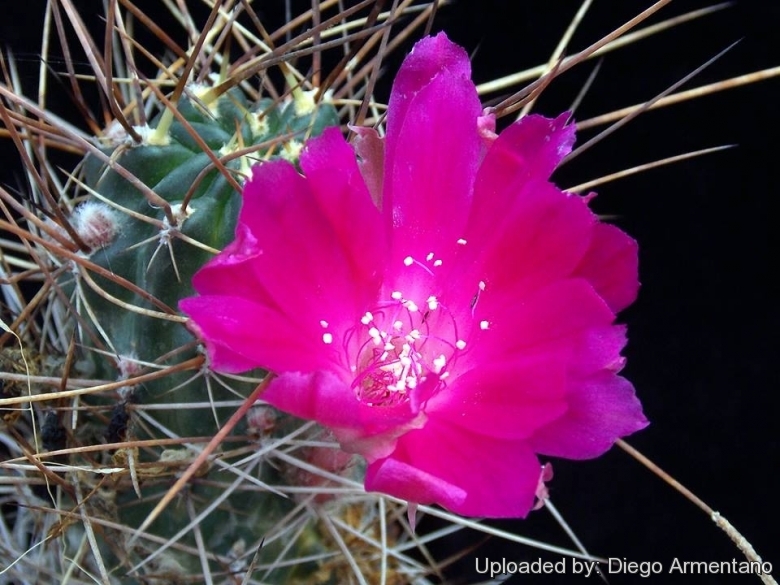= Echinopsis zecheri (Rausch) G.D.Rowley
1982
Accepted Scientific Name: Echinopsis backebergii Werderm. in Backeb.
Neue Kakteen 83, 84, fig. 1931 et: Fedde, Rep. Spec. Nov. 30: 64. 1932 Backeb. & Werderm.

Lobivia zecheri (Echinopsis zecheri) Photo by: Diego Armentano
Origin and Habitat: Ayacucho to Huanta, Ayacucho, Peru
Altitude range: 2400-3400 metres above sea level.
Synonyms:
See all synonyms of Echinopsis backebergii
back
Accepted name in llifle Database:Echinopsis backebergii Werderm. in Backeb.Neue Kakteen 83, 84, fig. 1931 et: Fedde, Rep. Spec. Nov. 30: 64. 1932Synonymy: 29
Cultivars
(1):
back
Description: Echinopsis zecheriSN|32674]]SN|9509]] (a.k.a. Lobivia zecheriSN|32675]]SN|9510]]) is a cold hardy species in the Cactus family (Cactaceae). This is one the several questionable varieties of the morphologically variable Echinopsis backebergiiSN|9502]]SN|9502]] (Lobivia backebergii), a taxon growing widespread in southern Bolivia and northern Peru. Echinopsis zecheriSN|9509]]SN|9509]] from Ayocucho is an attractive form with hard sharp spines and rather coarser flowers with rich liliac or purple petals and a white throat. However the distinguishing characteristics of Echinopsis zecheriSN|9509]]SN|9509]], appear to fall within the natural variation of Echinopsis backebergiiSN|9502]]SN|9502]] and it should be synonymized with the latter.
Note: W. Rausch, Lobivia 1985, consider this taxon an extreme form of Lobivia hertrichianaSN|9510]]SN|32675]] (Echinopsis hertrichianaSN|9509]]SN|32674]]) distinguished by the harder long spines.
Stems: Up to about 6 cm in diameter with straight ribs. Usually solitary but in age it may offsets forming small clump up to 20 cm in diameter.
Flowers: About 3-4 cm long and wide (occasionally larger), bright purple to liliac or violet with a white throat. Pistil and stamens pink to red violet. Flower colour, as elsewhere in the genus is quite variable.
Fruit: About 1 cm wide, drying at maturity with relatively large seeds.
Subspecies, varieties, forms and cultivars of plants belonging to the Echinopsis backebergii group
 Echinopsis backebergii Werderm. in Backeb.: has 1-11 spines, variable, unequal, about 4-50 mm long and very colourful flowers carmine-red or violet, often with white throats. Distribution: From South-east La Paz (Bolivia) to Huancavelica (Peru).
Echinopsis backebergii Werderm. in Backeb.: has 1-11 spines, variable, unequal, about 4-50 mm long and very colourful flowers carmine-red or violet, often with white throats. Distribution: From South-east La Paz (Bolivia) to Huancavelica (Peru). Echinopsis backebergii subs. wrightiana (Backeb.) M.Lowry: has long thin wispy spines and pale lilac flowers with often lighter throats. Distribution: Huancavelica, Central Peru.
Echinopsis backebergii subs. wrightiana (Backeb.) M.Lowry: has long thin wispy spines and pale lilac flowers with often lighter throats. Distribution: Huancavelica, Central Peru.- Echinopsis boedekeriana Harden
 Echinopsis winteriana (F.Ritter) D.R.Hunt: has large, funnel shaped, fuchsia pink to purple-violet flowers with white centre. Distribution: Huancavelica, Peru.
Echinopsis winteriana (F.Ritter) D.R.Hunt: has large, funnel shaped, fuchsia pink to purple-violet flowers with white centre. Distribution: Huancavelica, Peru. Echinopsis winteriana cv. Fluorescent (F.Ritter) D.R.Hunt: has colourful "shocking fuchsia pink" flowers with a bright white contrasting centre.
Echinopsis winteriana cv. Fluorescent (F.Ritter) D.R.Hunt: has colourful "shocking fuchsia pink" flowers with a bright white contrasting centre. Echinopsis zecheri (Rausch) G.D.Rowley: has harder sharp spines and rather coarser flowers with rich liliac or purple petals and a white throat. Distribution: Ayacucho, Peru.
Echinopsis zecheri (Rausch) G.D.Rowley: has harder sharp spines and rather coarser flowers with rich liliac or purple petals and a white throat. Distribution: Ayacucho, Peru. Lobivia wrightiana f. chilensis hort. ex E.Herzog
Lobivia wrightiana f. chilensis hort. ex E.Herzog
Bibliography: Major references and further lectures
1) Walter Rausch “Lobivia: The Day Flowering Echinopsidinae from a Geographical Distribution Point of View,” Volumes 1-3 R. Herzig, 1975
Cultivation and Propagation: Echinopsis zecheriSN|9509]]SN|9509]] grows rather slowly and it is sensitive to overwatering (rot prone) and needs a very good drainage to avoid rotting, but requires more moisture than true desert cacti to grow and produce flower. It is a very easy flowerer, if you keep it reasonably cool and absolutely dry during winter and lots of fresh air and sunshine tends to produce better plants and more flowers.
Soil: Use a loose well drained cactus mix.
Repotting: It require a deep pot suited to accommodate the swollen root, repotting with fresh potting-mix should be done every other year or when the plant has outgrown its pot. However, repotting doesn't necessarily mean they'll need larger containers.
Sun Exposure: Light shade when young, full sun later. Outside it likes strong sunshine, but is tolerant and do well with light shade during the hot Summer months. Tends to bronze in strong light, which encourages spine production.
Hardiness: It is cold resistant to -10° ( or even less depending on clones) for short periods of time. It will show its flowers only if we provide an adequate winter rest period.
Watering: Water regularly through the growing season. This can be done weekly or more frequently during the summertime, if the weather is sunny enough, but allow to dry fully before watering again. Kept this way, plants will show a healthy growth. Keep rather dry as soon as the temperature starts dropping in October and keep it dry in winter. The plant survives outside without protection in winter but is then somewhat prone to rot, too.
Fertilization: Give an occasional high potassium liquid feed during the active growing period.
Garden uses: It is a fine plant for a rock garden or container, contrasts well with agaves, yuccas, and low-growing flowering plants.
Pest and diseases: They are generally fairly easy to grow, especially if kept pest-free. They are susceptible to, scale insects and spider mite. Watch carefully for infestations of stem and root mealy bugs, and damage from these may well initiate fungal attack.
Propagation: Seeds, also can be grown from cutting as it branches from the base. Take cuttings spring or summer, let them dry till the ends callous well. Then replant them in fresh cactus soil that is ever so slightly moist, and keep it that way till they root. Surface sowing is the best; seeds germinate in 14-28 days at 20° C, remembering that seedlings dislike strong light and dry conditions.











